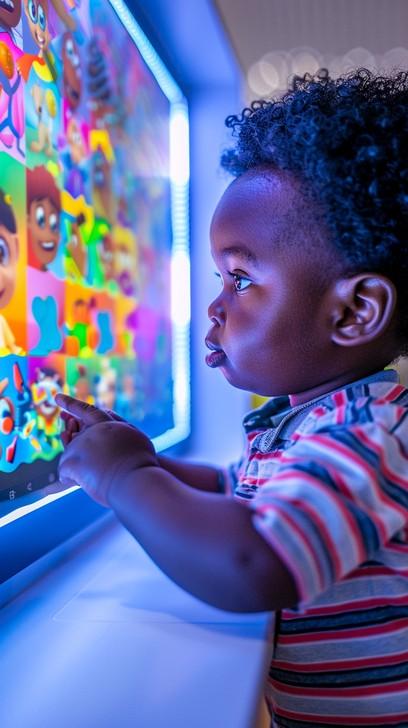In an era where digital devices are as ubiquitous as they are indispensable, the debate over screen time for children has intensified, often veering towards alarmism. Conventional wisdom suggests that imposing strict screen time limits is essential to protect the younger generation from the perils of excessive digital engagement. However, emerging evidence challenges this narrative, indicating that such restrictions might inadvertently do more harm than good. By examining the nuanced role that screens play in children’s development, this article seeks to unravel the complexities surrounding screen time. It aims to shift the discourse from one of fear to one grounded in a more holistic understanding of digital interaction, advocating for a balanced approach that considers both the potential benefits and the contextual needs of each child.
Reevaluating Screen Time Restrictions for Child Development
In an era where digital literacy is becoming as crucial as traditional literacy, it is imperative to reassess the conventional wisdom surrounding screen time limitations. Research increasingly suggests that rigid restrictions may inadvertently hinder a child’s ability to thrive in a tech-centric world. By imposing strict limits, we risk depriving children of opportunities to develop essential skills such as digital communication, problem-solving, and creativity. Rather than viewing screens as adversaries, they should be integrated thoughtfully into educational and recreational activities, providing a balanced approach that aligns with the realities of modern life.
Moreover, one-size-fits-all guidelines fail to account for the diverse ways children interact with technology. Not all screen time is created equal; distinguishing between passive consumption and active engagement is crucial. Consider these points:
- Interactive educational apps can foster critical thinking and engagement.
- Virtual collaboration tools prepare children for future work environments.
- Online resources can offer personalized learning experiences.
By focusing on the quality and context of screen interactions, parents and educators can create an environment where children are encouraged to harness technology as a tool for growth, rather than a source of concern.
Understanding the Psychological Impact of Limiting Screen Exposure
In the realm of child development, the psychological effects of restricting screen exposure can be profound and multifaceted. Children often experience feelings of anxiety and exclusion when their screen time is strictly limited. This anxiety stems from a fear of missing out (FOMO), a phenomenon that has been amplified in our digitally interconnected world. The modern social fabric is intricately woven with digital threads, and children who are cut off from these threads may feel isolated from their peers, leading to diminished self-esteem and social awkwardness.
Moreover, imposing stringent screen time limits can inadvertently stifle creativity and hinder learning opportunities. Consider the following potential impacts:
- Reduced access to educational resources and innovative learning platforms.
- Limited opportunities for children to engage in creative digital projects.
- Potential lack of development in digital literacy skills, which are crucial in today’s tech-centric society.
Balancing screen time with other activities, rather than imposing rigid restrictions, may provide a more holistic approach to nurturing a child’s psychological well-being.

Balancing Digital Interaction and Real-World Experiences for Children
In a world where digital interaction is increasingly intertwined with daily life, it’s crucial to reassess traditional notions of screen time limits for children. Rather than enforcing rigid restrictions, a more balanced approach can foster both digital literacy and real-world skills. By embracing technology as a tool for learning and creativity, parents can guide their children in making meaningful connections between their online activities and offline experiences.
- Encourage Creative Use: Digital devices should not just be a source of passive consumption. Encourage children to use technology for creative projects, such as digital storytelling or coding, which can enhance problem-solving skills and spark innovation.
- Integrate Technology with Physical Activities: Combining digital and real-world experiences can be beneficial. For example, apps that promote outdoor exploration or interactive learning games that require physical movement can bridge the gap between screens and tangible activities.
- Model Balanced Behavior: Children often mimic adult behaviors. Demonstrating a healthy balance between screen time and other activities sets a positive example. Engage in tech-free family activities that emphasize the value of interpersonal interactions and real-world exploration.
Ultimately, the goal is to cultivate a generation that can seamlessly navigate the digital realm while appreciating the richness of the physical world. By shifting focus from limiting screen time to enhancing its quality, we can empower children to thrive in both environments.

Empowering Parents with Effective Strategies Beyond Screen Limits
Instead of focusing solely on screen time limitations, it is essential to equip parents with a toolkit of diverse strategies that foster healthy habits in children. These strategies not only encourage balanced screen use but also promote critical thinking, creativity, and emotional intelligence. By shifting the focus from restrictions to enrichment, parents can nurture their children’s development in a more holistic manner.
- Model Healthy Behavior: Children often emulate the actions of adults. By demonstrating mindful technology use, parents can set a powerful example for their kids.
- Encourage Active Engagement: Instead of passive consumption, guide children towards interactive and educational content that stimulates their curiosity and learning.
- Promote Offline Activities: Balance is key. Encourage children to explore interests such as sports, arts, and reading, which provide a break from screens and contribute to their overall growth.
- Foster Open Communication: Discuss the content they engage with online. This dialogue helps children understand the impact of digital media and develop critical thinking skills.
- Set Collaborative Goals: Involve children in setting realistic screen time goals, making them active participants in managing their own habits.



